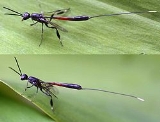
Gasteruptiidae
Encyclopedia

Apocrita
Apocrita is a suborder of insects in the order Hymenoptera.Apocrita includes wasps, bees and ants, and consists of many families. It includes the most advanced hymenopterans and is distinguished from Symphyta by the narrow "waist" formed between the first two segments of the actual abdomen; the...
n wasp
Wasp
The term wasp is typically defined as any insect of the order Hymenoptera and suborder Apocrita that is neither a bee nor an ant. Almost every pest insect species has at least one wasp species that preys upon it or parasitizes it, making wasps critically important in natural control of their...
s, with surprisingly little variation in appearance for a group that contains around 500 species in 9 genera worldwide. The propleura form an elongated "neck", the petiole
Petiole (insect)
In entomology, the term petiole is most commonly used to refer to the constricted first metasomal segment of members of the Hymenopteran suborder Apocrita; it may be used to refer to other insects with similar body shapes, where the metasomal base is constricted...
attaches very high on the propodeum
Propodeum
The propodeum is the first abdominal segment in Apocrita Hymenoptera . It is fused with the thorax to form the mesosoma. It is a single large sclerite, not subdivided, and bears a pair of spiracles. It is strongly constricted posteriorly to form the articulation of the petiole, and gives apocritans...
, and the hind tibia
Arthropod leg
The arthropod leg is a form of jointed appendage of arthropods, usually used for walking. Many of the terms used for arthropod leg segments are of Latin origin, and may be confused with terms for bones: coxa , trochanter , femur, tibia, tarsus, ischium, metatarsus, carpus, dactylus ,...
e are swollen and club-like. The females commonly have a long ovipositor
Ovipositor
The ovipositor is an organ used by some animals for oviposition, i.e., the laying of eggs. It consists of a maximum of three pairs of appendages formed to transmit the egg, to prepare a place for it, and to place it properly...
, and lay eggs in the nests of solitary bee
Bee
Bees are flying insects closely related to wasps and ants, and are known for their role in pollination and for producing honey and beeswax. Bees are a monophyletic lineage within the superfamily Apoidea, presently classified by the unranked taxon name Anthophila...
s and wasp
Wasp
The term wasp is typically defined as any insect of the order Hymenoptera and suborder Apocrita that is neither a bee nor an ant. Almost every pest insect species has at least one wasp species that preys upon it or parasitizes it, making wasps critically important in natural control of their...
s, where their larvae prey upon the host larvae and provisions.
The absence of "teeth" on the crown of the head and the somewhat thickened antennae readily separate these wasps from those in the unrelated family Stephanidae
Stephanidae
Stephanoidea is a small Hymenopteran superfamily that includes a single extant family, Stephanidae with 9 genera and almost 300 species, primarily tropical and subtropical in distribution...
, which also contains very slender wasps with long necks.
External links
- Gasteruption sp. Diagnostic photos of male and female imagines.
- Gasteruptiinae Tree of Life, extensive article.

